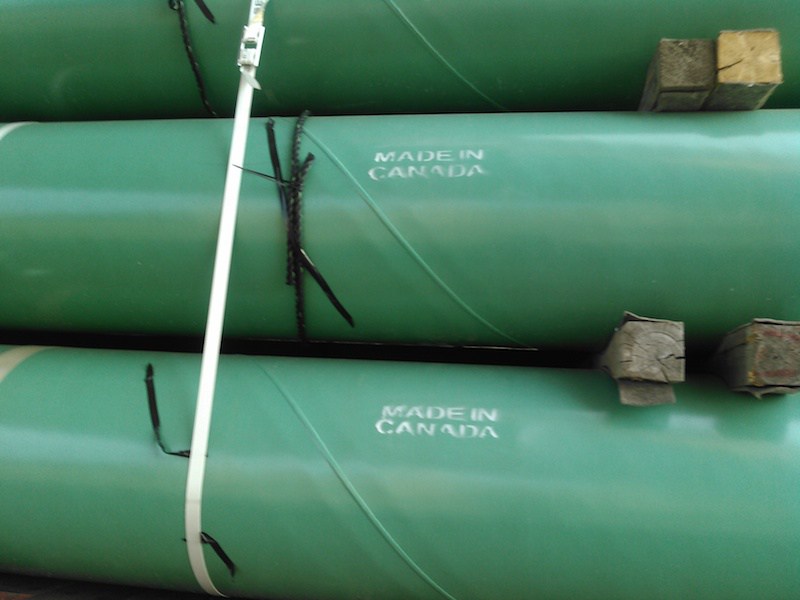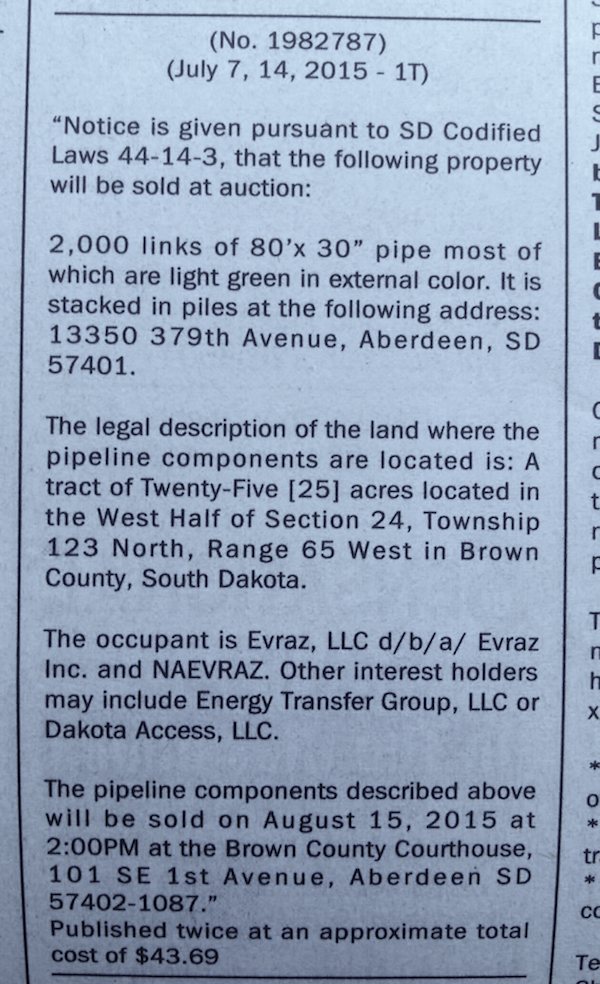At his February 16 press conference, President Donald Trump discussed his executive orders calling for U.S. federal agencies to grant TransCanada and Energy Transfer Partners the permits needed to build the Keystone XL and Dakota Access pipeline projects.
Trump also cited a different executive order signed that same day, highlighting the “Buy American measures” which he said were “in place to require American steel for American pipelines.” But like Keystone XL, as DeSmog previously reported, much of the steel for the Dakota Access project appears to have been manufactured in Canada by Evraz North America, a subsidiary of the Russian steel giant Evraz.
Evraz is owned in part by Roman Abramovich, a Russian multi-billionaire credited for bringing Russian President Vladimir Putin into office in the late 1990s. DeSmog’s finding comes on the heels of Trump’s former National Security Adviser Michael Flynn resigning for potentially having discussed U.S. sanctions against Russia with Russian diplomats before Trump took office, apparently without the knowledge of Trump or now-Vice President Mike Pence.
“Who Makes the Pipes?”
In his statement on using American steel for U.S. pipelines made at the press conference, Trump said “nobody ever asked before I came along.” He repeated the steel production talking point at his first campaign rally for the 2020 presidential cycle, made less than a month into his presidency, on February 18 in Melbourne, Florida.
“And very importantly, as I was about to sign it, I said who makes the pipe? Who makes the pipe?…Simple question,” he said. “The lawyers put this very complex document in front. I said, who makes the pipe? They said, sir, it can be made anywhere. I said not anymore. I put a little clause in the bottom. The pipe has to be made in the United States of America if we’re going to have pineline.”
Lisa Dillinger, who does media relations for Dakota Access, LLC, told DeSmog that 57 percent of the pipeline was manufactured in the U.S. by both Stupp Corporation in Baton Rouge, Louisiana and Welspun in Lake Charles, Louisiana. The remaining pipe, Dillinger said, was manufactured in Canada, though she did not comment on which Canadian company manufactured the steel.
Welspun does not appear to have a plant in Lake Charles, though it does have one in Little Rock, Arkansas. The company is headquartered in Mumbai, India, while Stupp is headquartered in Baton Rouge.
“Additionally, the majority of the remaining major materials were purchased, manufactured or assembled in the United States contributing nearly $1 billion in direct spending to the U.S. economy,” Dillinger said.
“Made in Canada”
In March 2015, the Dakota Free Press published photos of a line pipe storage site located in Brown County, South Dakota. One of those photos shows pipelines labeled “Made in Canada.”
Another photo published that same month by John Davis of the Aberdeen American News also shows the pipes were labeled “Made in Canada.” As Evraz North America points out on its website, it serves as the “only supplier of fully ‘Made in Canada’ [large diamater] pipe.”
“EVRAZ pioneered large diameter line pipe in North America and today we are its largest producer,” the company says on another section of its website. “In fact, we are the only producer in North America that can manufacture [large diamater] pipe that is 100% ‘Made in Canada.’”
Four months later in July 2015, Dakota Free Press published an image of an auction announcement from Aberdeen American News showing that 30 miles of line pipe in Brown County was up for auction. The occupant listed: Evraz North America. It also listed Dakota Access LLC as an interest holder.
Image Credit: Aberdeen American News
“The pipeline came by train to Brown County in preparation for construction of the Dakota Access oil pipeline, planned to carry Bakken oil across South Dakota to Illinois for refining,” wrote Cory Heidelberger of the Dakota Free Press. “Those 2,000 links would equal over 130 train car loads; my eyeball-recollection of the trains rumbling through Aberdeen last March suggests that 2,000 links are only a fraction of the stockpile.”
Indeed, that would only be a small fraction. According to a project announcement located by Desmog, Evraz and ETC Intrastate Procurement — the latter a subsidiary of Energy Transfer Partners — gave a contract to Dun Transportation & Stringing Inc. to offload and stockpile “61 miles of 30-in. pipe in Lincoln County, South Dakota” in February 2015. Dakota Access is a 30-inch diameter pipeline and runs through Lincoln County.
Dun, for what it’s worth, also lists unloading, hauling, and racking 185 miles of Evraz and Welspun steel in North and South Dakota for Dakota Access as one of its projects on its website.
Representatives for Dun did not respond to a request for comment submitted for this story. Evraz did not comment on how much steel it made for Dakota Access, referring DeSmog to its January 24 press release touting Trump’s executive orders.
“To the best of our information, EVRAZ North America is ‘the only supplier of fully ‘Made in Canada’ [large diamater] pipe,’ as is stated on our website,” Christian Messmacher, Vice President of Investor Relations and Strategy for Evraz North America, told DeSmog.
“Phony Claims”
Similar to Keystone XL, the steel production for the Dakota Access pipeline was a done deal long ago, well before the pipeline got all the permits it needed.
“Energy Transfer Partners was so eager to build the pipeline that it began staging mountainous piles of steel pipe across the four-state route before it had gotten all necessary easements and regulatory approval from federal regulators, as well as those in North Dakota, South Dakota, Iowa and Illinois,” a local Fox affiliate explained.
In the case of Dakota Access, nearly all of the pipeline already sits underground, other than the most contentious segment, which could soon go under Lake Oahe and the Missouri River located near the Standing Rock Sioux Tribe’s land in North Dakota. That segment consists of 0.02 percent of the line, according to Energy Transfer Partners.
Though many in leaders of the U.S. labor movement, including professional pipeliners, have praised Trump’s jobs initiatives, some within labor aren’t as elated and are more critical of Trump’s claims about creating U.S. steel jobs.
“American workers need jobs,” Jeremy Brecher, co-founder of the Labor Network for Sustainability, told DeSmog. “It is unconscionable that fossil fuel companies and Donald Trump exploit that need by making phony claims to be creating jobs — all to persuade us to support projects that will poison our air and water and make our planet unlivable for our kids. It’s time to get serious about creating jobs that protect our environment rather than destroying it.”
Photo Credit: Dakota Free Press | Cory Heidelberger
Subscribe to our newsletter
Stay up to date with DeSmog news and alerts








